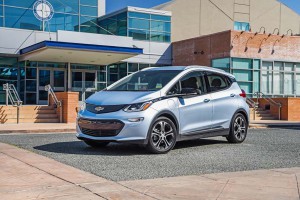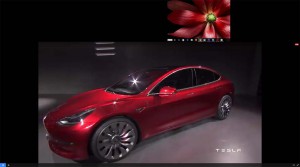
LG Chem VP Kang Chang Beom told his shareholders that Chevy Bolt sales would exceed 30,000 units in 2017. The supplier produces the batteries for the Bolt.
Just as Tesla revealed that the initial deliveries of its first mass-market EV, the Model 3, will be slow, one of the car’s competitors, the Chevrolet Bolt, appears to be ready to sprint out of the gate in 2017 with 30,000 deliveries.
The Bolt prediction comes from LG Chem Vice President Kang Chang Beom, whose company makes the batteries for Chevy’s new EV. His forecast that it would be raining Bolt EVs came during a conference call with the company’s shareholders, according to Bloomberg.
Sales of the new five-door plug-in EV begin later this year with production ramping up in early 2017 at General Motors’ plant in Orion, Michigan. However, Tesla’s first Model 3s won’t hit the streets until late next year … and even that’s considered a big assumption given the company’s past adherence to deadlines.
The fact that the two cars are drumming up such interest is actually a story unto itself. While everyone enjoys a budding rivalry, the larger trend is that plug-in electric vehicle sales are on the rise, according to new figures from the U.S. Department of Energy.
(Tesla warns of slow Model 3 deliveries. For more, Click Here.)
The agency’s Office of Energy Efficiency & Renewable Energy reports that 500,000 plug-ins have been sold since 2010 and the numbers are accelerating. Of those half million battery electrics, 250,000 have been purchased since the middle of 2014.

Tesla CEO Elon Musk expects to produce 500,000 Model 3s in 2018, but not everyone is convinced that will happen.
The introduction of the first mass market plug-in vehicles occurred in December 2010 with the introduction of the Chevrolet Volt and Nissan Leaf. By the end of 2012 there were 11 different plug-in models available.
For the past three years, sales of plug-in vehicles have averaged a little over 10,000 units per month. However, 2016 has been a different story as monthly sales records have been set five times since December 2015.
(Are these radical designs in VW’s future electric vehicle plans? Click Here for the story.)
Plug-in vehicle sales have jumped 38% compared within the last year to almost 110,000 vehicles this year, including more than 16,000 in September. If the sales rate continues, that means that the industry has already eclipsed last year’s record for battery-electric sales.
Those numbers only figure to escalate as new EV offerings continue. Right now, there are 27 battery-electric models for sale in the U.S. and automakers have been making promises for the last 12 to 18 months to grow that number.
If the prediction for the Bolt comes true, it would eclipse sales of the Model S last year with room to spare. It would also nearly double the results of the Chevy Volt from last year, although the new model introduced this year is selling ahead of the previous generation iteration, already beating last year’s totals.
(To find out more about Apple’s plans to ditch Project Titan, Click Here.)
In fact, aside from the Model S and Volt, the Nissan Leaf EV, BMW i3 EV and Ford Fusion Energi Plug-in Hybrid were the only models to break the 10,000-unit sales threshold in 2015. The Tesla Model S is expected to approach that 30,000 figure again this year.

Does the Bolt actually compete with the Model 3? It would seem to compete more with the Leaf and other micro / mini-cars, not the Model 3 or any of the Tesla vehicles.